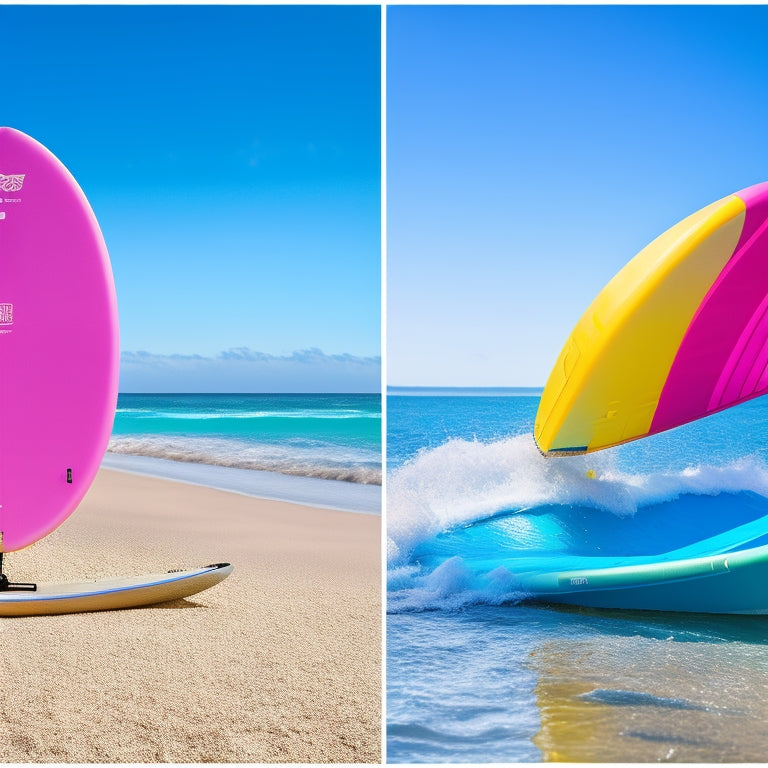
Foam Filling Secrets for Sturdier, Buoyant Boards
Share
I've experimented with various foam filling techniques to create a sturdier, more buoyant stand-up paddleboard. I've considered the weight implications, drying ability, and ventilation to prevent trapped air issues. Selecting the right foam type is essential, and I've explored options like EPS and closed-cell foam for their durability, insulation, and buoyancy benefits. Venting strategies are also key to preventing damage from expanding air. Now, I'm ready to share my approaches to combining foam with other materials and alternative solutions to refine the craft. From here, it's all about finding the perfect balance to build a stronger, lighter board.
Key Takeaways
• Balance foam filling to achieve a sturdier SUP by considering added weight, drying ability, and ventilation to prevent trapped air issues.
• Select the right foam type based on buoyancy, insulation, and integrity needs, considering EPS foam, closed-cell foam, and their characteristics.
• Implement effective venting solutions to address trapped air in closed-cell foam, including glassing interior and exterior to prevent seam bursting.
• Combine foam with other materials to enhance structural integrity, such as wrapping EPS foam, reinforcing joints, and tabbing joints with additional material.
• Explore alternative solutions like inspection ports, partially filled beach balls, and creative venting strategies to achieve a sturdier and more buoyant board.
Foam Filling Considerations
When considering foam filling for your stand-up paddleboard (SUP), it's important to weigh the benefits against the potential drawbacks. These include added weight, reduced drying ability, and the need for ventilation to prevent trapped air from expanding and contracting.
As I consider adding foam to my board, I think about the weight considerations - will the extra pounds affect my performance? The insulation benefits, on the other hand, are a major draw for me. I've heard that foam filling can reduce flex in the board, making it feel more buoyant and lively.
But I also know that I'll need to account for ventilation to avoid trapped air issues. It's a delicate balance, but one that's worth striking to achieve a sturdier, more reliable SUP.
Foam Types and Characteristics
As I explore the world of foam filling, I'm faced with a pivotal decision: choosing the right type of foam that will provide the perfect balance of structural integrity, buoyancy, and insulation for my stand-up paddleboard.
I need to ponder the characteristics of different foam types to make an informed decision. EPS foam, for instance, is a popular choice due to its durability and resistance to epoxy dissolution. Closed-cell foam, on the other hand, is excellent at trapping gas, making it ideal for insulation. However, its cells can break down if water infiltrates, compromising its performance.
Understanding these characteristics is essential in selecting the right foam for my board, ensuring it remains buoyant, sturdy, and safe to ride. With the right foam, I can create a board that's both enjoyable and secure.
Venting and Expansion Strategies
I must carefully contemplate venting strategies to prevent air expansion and contraction in my foam-filled stand-up paddleboard, as trapped air can cause significant issues down the line.
Venting challenges arise when closed-cell foam traps expanding air, leading to potential damage or even board failure. To overcome this, I need to implement effective venting solutions.
One approach is to glass the interior and exterior of the board to prevent seam bursting due to trapped air. Another strategy is to explore venting options that allow for air circulation, ensuring that expanding air can escape safely.
Combining Foam With Other Materials
In addition, wrapping EPS foam in packing tape or Saran wrap before installation helps prevent it from absorbing epoxy resin, ensuring a strong bond between the foam and surrounding materials.
This simple step can make a huge difference in the overall structural integrity of my board.
When combining foam with other materials, I also consider reinforcing joints to prevent failure due to different coefficients of expansion. By tabbing joints with additional material, I can increase the strength and durability of my board.
Moreover, I explore various buoyancy options, such as using a combination of EPS foam and 2-liter bottles, to achieve the perfect balance of weight and buoyancy.
Alternative Solutions and Experiences
While experimenting with foam filling, I've come across users who've implemented innovative solutions to achieve prime buoyancy and structural support in their boards.
One user installed inspection ports for cross ventilation in water-soaked foam, ensuring air circulation and preventing trapped air from causing issues.
Another used bricks of foam adhered to the hull for airflow in older boats.
I've also seen the use of partially filled beach balls for added buoyancy in small sailboats.
These alternative solutions demonstrate the creativity and resourcefulness of the foam-filling community. By sharing our experiences and experimenting with different approaches, we can refine our techniques and create sturdier, more buoyant boards that prioritize safety and performance.
Foam Filling Methods and Benefits
Filling board cavities with EPS foam provides significant structural integrity, allowing you to achieve a more buoyant and lively ride while reducing flex in the board. By incorporating foam, I've noticed a substantial improvement in my board's performance.
Here are some key benefits:
-
Buoyancy advantages: Foam filling provides a more stable and responsive ride, making it perfect for fishing and paddling activities.
-
Structural integrity: Foam adds strength to the board, reducing the risk of damage and ensuring a safer experience.
-
Weight considerations: While foam adds weight, it's essential to balance this with the benefits of increased buoyancy and structural integrity.
Building Stronger, Lighter Boards
By strategically combining foam filling with clever material selection and design tweaks, I've been able to craft boards that are both stronger and lighter, perfect for tackling various water conditions. To achieve this, I focus on ideal weight distribution, ensuring that the foam filling complements the board's design rather than hindering it. Durability testing is also essential, as it helps me identify areas where the foam filling can be optimized for maximum strength and buoyancy.
| Design Element | Benefits |
|---|---|
| Foam-filled compartments | Increased buoyancy and structural integrity |
| Strategically placed ventilation | Prevents air expansion and trapped air issues |
| Clever material selection | Enhanced weight distribution and durability |
| Design tweaks | Improved performance and maneuverability |
| Durability testing | Identification of areas for optimization and improvement |
Frequently Asked Questions
Can I Use Foam Filling in a Wooden Paddleboard?
As I consider using foam filling in a wooden paddleboard, I weigh the pros and cons, thinking about how it'll impact wooden durability and aesthetic appeal, ensuring the added buoyancy doesn't compromise safety or the board's overall performance.
How Do I Determine the Right Amount of Foam for My Board?
"How much foam is too much foam? I calculate the volume of my board's cavities and consider the density of the foam I'm using to determine the right amount, ensuring a sturdy yet buoyant ride."
Will Foam Filling Affect the Resale Value of My Board?
"I wonder if foam filling will impact my board's resale value; potential buyers might worry about inspection worries and long-term depreciation, but if done right, it could be a unique selling point."
Can I Use Foam Filling in a Board With a Soft Deck?
"I'm terrified of a soft deck turning into a mushy mess! If I fill my board with foam, will it compromise deck durability? I'm worried the softening effects will make it vulnerable to damage and affect its overall performance."
Are There Any Certifications for Foam-Filled Paddleboards?
I've searched for certifications specific to foam-filled paddleboards, but I haven't found any industry-recognized standards. However, I do recommend following established guidelines for foam usage in boat building and ensuring compliance with local safety regulations.
Related Posts
-

Community Engagement: Learning Through Professions
Community engagement is a powerful tool for fostering a deeper understanding of various professions among children. B...
